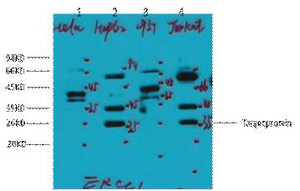PPAR α (Phospho Ser21) rabbit pAb
- Catalog No.:YP1700
- Applications:WB
- Reactivity:Human;Mouse;Rat
- Target:
- PPAR α
- Fields:
- >>PPAR signaling pathway;>>cAMP signaling pathway;>>Adipocytokine signaling pathway;>>Glucagon signaling pathway;>>Insulin resistance;>>Non-alcoholic fatty liver disease;>>Alcoholic liver disease;>>Hepatitis C;>>Chemical carcinogenesis - receptor activation;>>Diabetic cardiomyopathy
- Gene Name:
- PPARA NR1C1 PPAR
- Protein Name:
- PPAR α (Phospho-Ser21)
- Human Gene Id:
- 5465
- Human Swiss Prot No:
- Q07869
- Mouse Gene Id:
- 19013
- Mouse Swiss Prot No:
- P23204
- Rat Gene Id:
- 25747
- Rat Swiss Prot No:
- P37230
- Immunogen:
- Synthesized peptide derived from human PPAR α (Phospho-Ser21)
- Specificity:
- This antibody detects endogenous levels of PPAR α (Phospho-Ser21) at Human, Mouse,Rat
- Formulation:
- Liquid in PBS containing 50% glycerol, 0.5% BSA and 0.02% sodium azide.
- Source:
- Polyclonal, Rabbit,IgG
- Dilution:
- WB 1:500-2000
- Purification:
- The antibody was affinity-purified from rabbit serum by affinity-chromatography using specific immunogen.
- Concentration:
- 1 mg/ml
- Storage Stability:
- -15°C to -25°C/1 year(Do not lower than -25°C)
- Other Name:
- Peroxisome proliferator-activated receptor alpha (PPAR-alpha) (Nuclear receptor subfamily 1 group C member 1)
- Molecular Weight(Da):
- 51kD
- Background:
- peroxisome proliferator activated receptor alpha(PPARA) Homo sapiens Peroxisome proliferators include hypolipidemic drugs, herbicides, leukotriene antagonists, and plasticizers; this term arises because they induce an increase in the size and number of peroxisomes. Peroxisomes are subcellular organelles found in plants and animals that contain enzymes for respiration and for cholesterol and lipid metabolism. The action of peroxisome proliferators is thought to be mediated via specific receptors, called PPARs, which belong to the steroid hormone receptor superfamily. PPARs affect the expression of target genes involved in cell proliferation, cell differentiation and in immune and inflammation responses. Three closely related subtypes (alpha, beta/delta, and gamma) have been identified. This gene encodes the subtype PPAR-alpha, which is a nuclear transcription factor. Multiple alternatively spliced transcript variants have been described for thi
- Function:
- function:Receptor that binds peroxisome proliferators such as hypolipidemic drugs and fatty acids. Once activated by a ligand, the receptor binds to a promoter element in the gene for acyl-CoA oxidase and activates its transcription. It therefore controls the peroxisomal beta-oxidation pathway of fatty acids.,online information:Peroxisome proliferator-activated receptor entry,similarity:Belongs to the nuclear hormone receptor family. NR1 subfamily.,similarity:Contains 1 nuclear receptor DNA-binding domain.,subunit:Heterodimer with the retinoid X receptor. Interacts with NCOA3 and NCOA6 coactivators, leading to a strong increase of transcription of target genes. Also interacts with PPARBP coactivator in vitro. Interacts with AKAP13.,tissue specificity:Skeletal muscle, liver, heart and kidney.,
- Subcellular Location:
- Nucleus.
- Expression:
- Skeletal muscle, liver, heart and kidney. Expressed in monocytes (PubMed:28167758).
- June 19-2018
- WESTERN IMMUNOBLOTTING PROTOCOL
- June 19-2018
- IMMUNOHISTOCHEMISTRY-PARAFFIN PROTOCOL
- June 19-2018
- IMMUNOFLUORESCENCE PROTOCOL
- September 08-2020
- FLOW-CYTOMEYRT-PROTOCOL
- May 20-2022
- Cell-Based ELISA│解您多样本WB检测之困扰
- July 13-2018
- CELL-BASED-ELISA-PROTOCOL-FOR-ACETYL-PROTEIN
- July 13-2018
- CELL-BASED-ELISA-PROTOCOL-FOR-PHOSPHO-PROTEIN
- July 13-2018
- Antibody-FAQs



